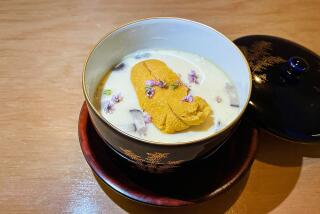Wines of the week: Chenin blancs
Wine trends in California can be exceedingly subtle, particularly when they involve wines as transparent as Chenin Blanc, a white variety that’s been around for more than a century in California. For about the last 30 years, it’s gone largely overlooked and unregarded, until a dozen or so local artisans rediscovered it, resulting in a mini-renaissance for a white wine that’s as old school as California gets.
Chenin blanc originates in France, primarily in the central Loire regions of Anjou, Montlouis, Vouvray and Savennieres, where the grape is capable of multiple styles, depending on the warmth and length of the vintage — this is how Chenin, with Riesling, has come to be viewed as one of the great barometers of climate terroir expression in the world.
Here in California, the stylistic range is less dramatic but is getting more interesting all the time, as young winemakers prize its affordability, its relative ease of use — no new barrels, early releases, immediate cash flow — and bracing, anti-Chardonnay vibe.
See the most-read stories in Life & Style this hour »
California’s 2015 grape census lists 5,183 acres of Chenin in the California soils, much of it older plantings, vestiges of an era in the ’70s and ’80s when American tastes ran toward white wines. Most though were lackluster, and fairly sweet at that — though Charles Krug’s varietal bottling was highly prized. Just a few decades ago, it was the most popular premium wine in America. Meanwhile a few Napa properties — Pine Ridge Chappellet and Lang & Reed, Napa’s Loire-inspired winery — have worked with the grape even as tastes veered elsewhere. As reds overtook California’s grape output, Chenin was bypassed; overcropped, anemic iterations filled out anonymous blends and jug wines with its watery, phlegmatic temperament.
But the cool thing about underappreciated vineyards is that they improve as they age. Vines recalibrate their physiological efforts toward producing quality fruit, which usually gets more concentrated, more complex, more characterful, like the vines at Buddha Dharma Vineyard, owned by a Buddhist community near Mendocino. Saddled with a long-term contract with a bulk wine producer, the vineyard has survived into its eighth decade, long enough for winemaker Pax Mahle to discover, disentangle existing contractual obligations and resurrect the site. Talk about karma.
Just as in France, producers here are experimenting with levels of ripeness — though unlike France, producers here aren’t dodging summer hailstorms or fall rains, so control over their picking dates is that much more exacting. The better of these wines are thrilling and racy, with a green-apple, limeaid pucker of acidity that makes them brilliant with seafood and summery fare. Vanguard California Chenin producers include Lieu Dit, Precedent, Birichino, Forlorn Hope, Pax, Roark, Field Recordings. Taken together, they’re as pure and electric a group of white wines as any in California.
2014 Sandlands Amador County Chenin Blanc
Turley winemaker Tegan Passalacqua debuted his own brand, Sandlands, in 2010, and makes not one but three Chenins. This one is drawn from vines planted in 1979, leading with a scent of Meyer lemon and fennel pollen, with a slightly richer core of fruit, like wedge of Bosc pear, lightly salted. About $24 at Wine House, , and Silver Lake Wine and Domaine LA.
2015 Habit Santa Ynez Valley Jurassic Park Vineyard Chenin Blanc
From vines planted in 1978, Angeleno (and “American Dad” cartoon character) Jeff Fischer’s frisky white has a lingering scent of white flower petals and a hint of peach. The flavors are more citrusy and stony, bone dry, with some breadth coming from aging on lees. About $30 at Esters, Everson Royce, Wine Exchange and Wine Country.
2014 LoFi Santa Ynez Valley Jurassic Park Vineyard Chenin Blanc
Winemaker Mike Roth makes two picks of his Chenin blocks at Jurassic Park Vineyard for his Central Coast wine brand, LoFi: the first to give the wine nerve and a ripple of acidity, the second comes weeks later, when the fruit is riper, for added richness and phenolic grip. There’s a presence and length in the texture here that hints at the range this variety can express. About $26 at Domaine LA, Everson Royce and Silver Lake Wine.
More to Read
Eat your way across L.A.
Get our weekly Tasting Notes newsletter for reviews, news and more.
You may occasionally receive promotional content from the Los Angeles Times.






